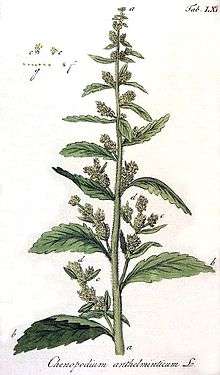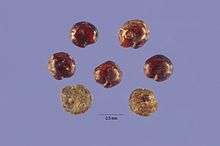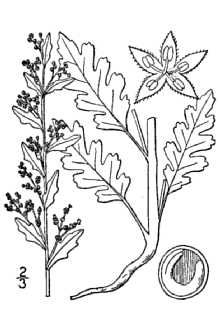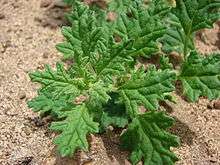Dysphania (plant)
| Dysphania | |
|---|---|
 | |
| Dysphania anthelmintica, American Wormseed | |
| Scientific classification | |
| Kingdom: | Plantae |
| (unranked): | Angiosperms |
| (unranked): | Eudicots |
| (unranked): | Core eudicots |
| Order: | Caryophyllales |
| Family: | Amaranthaceae |
| Subfamily: | Chenopodioideae |
| Tribe: | Dysphanieae |
| Genus: | Dysphania R.Br. |
| species | |
|
about 43 species, see text | |
Dysphania is a plant genus in the family Amaranthaceae, distributed worldwide from the tropics and subtropics to warm-temperate regions.
Description
The species of genus Dysphania are annual plants or short-lived perennials. They are covered with stalked oder sessile glandular hairs and therefore with aromatic scent (or malodorous to some people). Some species have uniseriate multicellular trichomes, rarely becoming glabrous. The stems are erect, ascending, decumbent, or prostrate and mostly branched.
The alternate leaves are mostly petiolate, (the upper ones sometimes sessile). The leaf blade is linear, lanceolate, oblanceolate, ovate, or elliptic, often pinnately lobed, with cuneate or truncate base, anentire, dentate, or serrate margins.
The Inflorescences are terminal, loose, simple or compound cymes or dense axillary glomerules. Bracts are absent or reduced. Flowers are bisexual (rarely unisexual), with 1-5 tepals connate only basally or fused to form sac, 1-5 stamens, and a superior ovary with 1-3 filiform stigmas.

The fruit is often enclosed in perianth. The membranous pericarp is adherent or nonadherent to the horizontal or vertical, subglobose or lenticular seed. The seed coat is smooth or rugose. The annular or incompletely annular embryo is surrounding the copious farinose perisperm.
Chromosome numbers
Chromosome numbers reported are 2n=16, 18, 32, 36 and 48.[1]
Photosynthesis pathway
All species of genus Dysphania are C3-plants with normal leaf anatomy.[2]
Distribution
The genus Dysphania is distributed worldwide from the tropics and subtropics to warm-temperate regions. In Europe, the species are native, archaeophytes, or naturalized, in the northern regions absent or rarely adventive.[3]
Systematics
The genus Dysphania belongs to the tribe Dysphanieae in the subfamily Chenopodioideae within the plant family Amaranthaceae. According to phylogenetic research, it is related to genera Suckleya and Cycloloma.[2]
Dysphania was first published in 1810 by Robert Brown in Prodromus Florae Novae Hollandiae, p. 411-412.[4] Type species is Dysphania littoralis R.Br.. The genus name Dysphania derives from the Greek dysphanis, meaning obscure, probably referring to the inconspicuous flowers.
The genus Dysphania primarily comprised 7-10 Australian species. Sometimes they were grouped as an own family, Dysphaniaceae Pax & Hoffmann, or even regarded as members of families Illecebraceae and Caryophyllaceae. In 2002, Sergei L. Mosyakin & Steven E. Clemants extended the genus for the glandular species of Chenopodium subgenus Ambrosia A.J.Scott.
Synonyms for Dysphania R.Br. are Neobotrydium Moldenke, Roubieva Moq. and Teloxys Moq..


The genus Dysphania consists of 5 sections with about 43 species:
- Dysphania sect. Adenois (Moq.) Mosyakin & Clemants: 15 species, native in South and Middle America, now distributed worldwide from the tropics to warm-temperate regions:
- Dysphania ambrosioides (L.) Mosyakin & Clemants (Syn.: Chenopodium ambrosioides L.), Epazote, Mexican-tea: native in North- and South America, naturalized in other continents.
- Dysphania andicola (Phil.) Mosyakin & Clemants (Syn.: Ambrina andicola Phil., Chenopodium ambrosioides var. andicola (Phil.) Aellen)
- Dysphania anthelmintica (L.) Mosyakin & Clemants, Syn.: Chenopodium anthelminticum L., Chenopodium ambrosioides var. anthelminticum (L.) A.Gray), Wormseed, American wormseed: native in North America and Caribic, cultivated or naturalized in other continents.
- Dysphania burkartii (Aellen) Mosyakin & Clemants (Syn.: Chenopodium ambrosioides L. subsp. burkartii Aellen, Chenopodium burkartii (Aellen) Vorosch.)
- Dysphania chilensis (Schrad.) Mosyakin & Clemants (Syn.: Chenopodium chilense Schrad., Chenopodium ambrosioides var. chilense (Schrad.) Spegazzini; Chenopodium ambrosioides var. vagans (Standley) J.T.Howell): native in Argentina and Chile.
- Dysphania dunosa (L.E.Simón) Mosyakin & Clemants (Syn.: Chenopodium dunosum L.E.Simón)
- Dysphania multifida (L.) Mosyakin & Clemants, Syn.: Chenopodium multifidum L., Roubieva multifida (L.) Moq., Teloxys multifida (L.) W.A.Weber), Cut-leaf goosefoot, small-leaved wormseed: native in South America, introduced from the tropics to warm-temperate regions.
- Dysphania oblanceolata (Speg.) Mosyakin & Clemants (Syn.: Chenopodium ambrosioides L. var. oblanceolatum Speg., Chenopodium oblanceolatum (Speg.) Giusti)
- Dysphania retusa (Juss. ex Moq.) Mosyakin & Clemants (Syn.: Chenopodium retusum Juss. ex Moq.)
- Dysphania sooana (Aellen) Mosyakin & Clemants (Syn.: Chenopodium sooanum Aellen)
- Dysphania tomentosa (Thouars) Mosyakin & Clemants (Syn.: Chenopodium tomentosum Thouars)
- Dysphania venturii (Aellen) Mosyakin & Clemants (Syn.: Chenopodium ambrosioides L. subsp. venturii Aellen, Chenopodium venturii (Aellen) Cabrera)
- Dysphania sect. Botryoides (C.A.Mey.) Mosyakin & Clemants: with 3 subsections:
- Dysphania sect. Botryoides subsect. Botrys (Aellen & Iljin) Mosyakin & Clemants:with 9 species, worldwide, native in southern North America, northern South America, southern Eurasia and Africa.
- Dysphania botrys (L.) Mosyakin & Clemants, Syn.: Chenopodium botrys L.), Jerusalem-oak, feather-geranium: native from Middle Europa to China (Xinjiang), naturalized or cultivated in other temperate regions.
- Dysphania nepalensis (Colla) Mosyakin & Clemants (Syn.: Chenopodium nepalense Colla), in Central Asia
- Dysphania procera (Hochst. ex Moq.) Mosyakin & Clemants (Syn.: Chenopodium procerum Hochst. ex Moq.)
- Dysphania pseudomultiflora (Murr) Verloove & Lambinon (Syn.: Chenopodium foetidum Schrad. subsp. pseudomultiflorum Murr): In South Africa.
- Dysphania schraderiana (Schult.) Mosyakin & Clemants, Syn. Chenopodium schraderianum Schult.)
- Dysphania sect. Botryoides subsect. Incisa (Standley) Mosyakin & Clemants: With 3 species in southwestern North America and in South America:
- Dysphania dissecta (Moq.) Mosyakin & Clemants (Syn.: Ambrina dissecta Moq., Chenopodium dissectum (Moq.) Standley)
- Dysphania graveolens (Willd.) Mosyakin & Clemants, Syn.: Chenopodium graveolens Willd., Chenopodium incisum Poiret, Teloxys graveolens (Willd.) W.A.Weber): native in North and South America, introduced in other continents.
- Dysphania mandonii (S.Watson) Mosyakin & Clemants (Syn.: Teloxys mandonii S.Watson, Chenopodium mandonii (S.Watson) Aellen)
- Dysphania sect. Botryoides subsect. Botrys (Aellen & Iljin) Mosyakin & Clemants:with 9 species, worldwide, native in southern North America, northern South America, southern Eurasia and Africa.
- Dysphania sect. Dysphania, with 8 species in Australia:[5]
- Dysphania glandulosa Paul G.Wilson, in Australia
- Dysphania glomulifera Paul G.Wilson (Syn.: Dysphania myriocephala Benth., Chenopodium myriocephalum (Benth.) Aellen), in Australia
- Dysphania kalpari Paul G.Wilson, in Australia
- Dysphania littoralis R.Br., in Australia
- Dysphania plantaginella F.Muell., in Australia
- Dysphania platycarpa Paul G.Wilson, in Australia
- Dysphania rhadinostachya (F.Muell.) A.J.Scott (Syn.: Chenopodium rhadinostachyum F. Muell.), in Australia
- Dysphania simulans F.Muell. & Tate ex Tate, in Australia
- Dysphania sphaerosperma Paul G.Wilson, in Australia
- Dysphania valida Paul G.Wilson, in Australia
- Dysphania sect. Orthospora (R.Br.) Mosyakin & Clemants: with 7 species in New Zealand and Australia, some species introduced in other regions:
- Dysphania carinata (R.Br.) Mosyakin & Clemants, Syn.: Chenopodium carinatum R.Br.): native in Australia, naturalized in other continents.
- Dysphania cristata (F.Muell.) Mosyakin & Clemants), Syn.: Blitum cristatum F.Muell., Chenopodium cristatum (F.Muell.) F.Muell.): native in Australia, naturalized in other continents.
- Dysphania melanocarpa (J.M.Black) Mosyakin & Clemants (Syn.: Chenopodium carinatum R.Br. var. melanocarpum J.M.Black, Chenopodium melanocarpum (J.M.Black) J.M.Black), black crumbweed
- Dysphania pumilio (R.Br.) Mosyakin & Clemants, Syn.: Chenopodium pumilio R.Br., Teloxys pumilio (R.Br.) W.A.Weber), Clammy goosefoot, small crumbweed: native in Australia, naturalized in other continents.
- Dysphania pusilla Mosyakin & Clemants (Syn.: Chenopodium pusillum Hook. f.)
- Dysphania saxatilis (Paul G.Wilson) Mosyakin & Clemants (Syn.: Chenopodium saxatile P.G.Wilson)
- Dysphania truncata (Paul G.Wilson) Mosyakin & Clemants (Syn.: Chenopodium truncatum P.G.Wilson)
- Dysphania sect. Roubieva (Moq.) Mosyakin & Clemants
- Dysphania bonariensis (Hook.f.) Mosyakin & Clemants, Syn.: Roubieva bonariensis Hook. f., Chenopodium haumanii Ulbr.)
- Dysphania microcarpa (Phil.) Mosyakin & Clemants (Syn.: Roubieva microcarpa Phil.)
- Not yet grouped to a section:
- Dysphania congolana (Hauman) Mosyakin & Clemants (Syn.: Chenopodium glaucum L. var. congolanum Hauman, Chenopodium congolanum (Hauman) Brenan), in Africa
- Dysphania minuata (Aellen) Mosyakin & Clemants (Syn.: Chenopodium minuatum Aellen)
- Dysphania stellata (Standley) Mosyakin & Clemants (Syn.: Chenopodium stellatum S.Watson): This species has 6-8 tepals.
Excluded species: Teloxys aristata (Syn. Dysphania aristata (L.) Mosyakin & Clemants, Chenopodium aristatum L.).[6]
Vernacular names
- Chinese: 刺藜属 ci li shu
Usage
Epazote or Mexican Tea (Dysphania ambrosioides) and American wormseed (Dysphania anthelmintica) are medicinal herbs, Epazote is used as tea. They are also used als insecticides.[7]
Some species of Dysphania are used as dye.[7][8]
References
- Steven E. Clemants & Sergei L. Mosyakin (2003): Dysphania - online. In: Flora of North America Editorial Committee (ed.): Flora of North America North of Mexico. Volume 4: Magnoliophyta: Caryophyllidae, part 1. Oxford University Press, New York, ISBN 0-19-517389-9, p. 267. (chapters description, distribution, systematics)
- Sergei L. Mosyakin, Steven E. Clemants (2008): Further Transfers of glandular-pubescent species from Chenopodium subg. Ambrosia to Dysphania (Chenopodiaceae). In: Journal of the Botanical Research Institute of Texas Vol.2, Nr. 1, p. 425–431. (chapter systematics)
- Gelin Zhu, Sergei L. Mosyakin & Steven E. Clemants (2003): Chenopodiaceae: Dysphania – online. In: Wu Zhengyi, Peter H. Raven, Deyuan Hong (Hrsg.): Flora of China. Volume 5: Ulmaceae through Basellaceae. Science Press u.a., Beijing u.a., ISBN 1-930723-27-X, p. 376. (chapter description, vernacular name)
- species and distribution at GRIN, retrieved 30 November 2011
- ↑ Erich Oberdorfer, Theo Müller (1983): Pflanzensoziologische Exkursionsflora. 5. ed., Ulmer, Stuttgart, ISBN 3-8001-3429-2, p.342
- 1 2 Gudrun Kadereit, Evgeny V. Mavrodiev, Elizabeth H. Zacharias, Alexander P. Sukhorukov (2010): Molecular phylogeny of Atripliceae (Chenopodioideae, Chenopodiaceae): Implications for systematics, biogeography, flower and fruit evolution, and the origin of C4 Photosynthesis. In: American Journal of Botany, 97(10), p. 1664–1687.
- ↑ Pertti Uotila (2011): Chenopodiaceae (pro parte majore). – In: Euro+Med Plantbase – the information resource for Euro-Mediterranean plant diversity. Dysphania. Euro+Med Plantbase, retrieved 30 November 2011.
- ↑ First publication scanned at Biodiversity Heritage Library
- ↑ Tropicos, retrieved 30 November 2011.
- ↑ "Teloxys aristata". Germplasm Resources Information Network (GRIN). Retrieved 26 November 2015.
- 1 2 Dysphania ambrosioides at Liber Herbarum, retrieved 30 November 2011.
- ↑ Dysphania schraderiana at Liber Herbarum, retrieved 30 November 2011.
External links
| Wikimedia Commons has media related to Dysphania. |